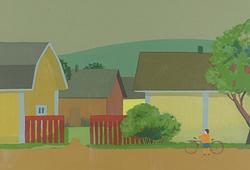Bruno Liljefors
Skogsglänta med dimstråk
Signerad B.L. Troligen utförd under 1890-talet. Tuschlavering på papper 15,5 x 24 cm.
More information
Katalognumret tillhör, med största sannolikhet, konstnärens 1890-talsproduktion. Genom den valda tekniken suggereras effektivt morgonljuset över skog och mark. Stilistiskt är katalognumret jämförbart med "Tjäderlek" (lavering 32 x 20 cm) och "Berguv" (lavering 12 x 14,5 cm) bägge från 1890-talet (Nationalmuseum resp. privat ägo, jfr Allan Ellenius, "Bruno Liljefors. Naturen som livsrum", 1996/1997, sid 98 resp. 159). I dessa bilder kanaliseras naturkänslan mot stämningsinnehållet och inte till de många enskildheterna i landskapet vilket ofta är fallet med Liljefors bilder från 1880-talet.
Designer
Bruno Liljefors is the Swedish artist best known for his nature and animal motifs, especially in dramatic situations. Liljefors started with studies at the Academy of Arts in 1879, and continued 1882 in Düsseldorf where the studies revolved around animal painting. The journey then continued to Venice, Rome, Naples, Paris and Grez. Once back in Sweden, he began to draw and paint animals, especially cats and small birds, from the beginning in intimate interaction with nature. He then moved on to broader depictions of wild animals and nature, of seascapes with seabirds and of dramatic scenes of battles between birds. Liljefors is known as our country's foremost animal painter with a large production. Liljefors depicted, in contrast to the "idyllic" animal painting, the animals everyday life with a focus on movement, anatomy and their adaptation to the landscape. This is where the greatness of his painting lies, in the ability to show the animals in their proper environment. He has achieved this by hunting and observing. Well-known works of art are the paintings "Rävfamilj" (1886) and "Havsörnar" (1897), as well as the sculpture "Lek" (1930) at Stockholm Stadium. Liljefors is mainly represented at the National Museum, Waldemarsudde and the Thielska gallery in Stockholm.
Read more



























